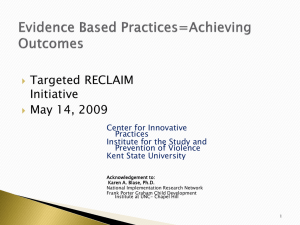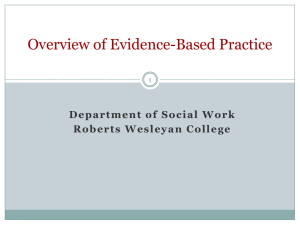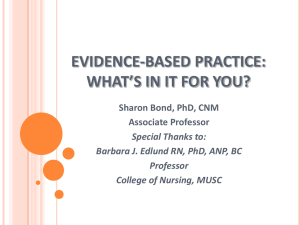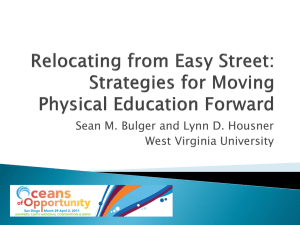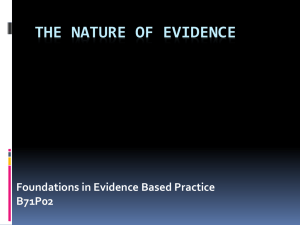Advancing Evidence Based Practice
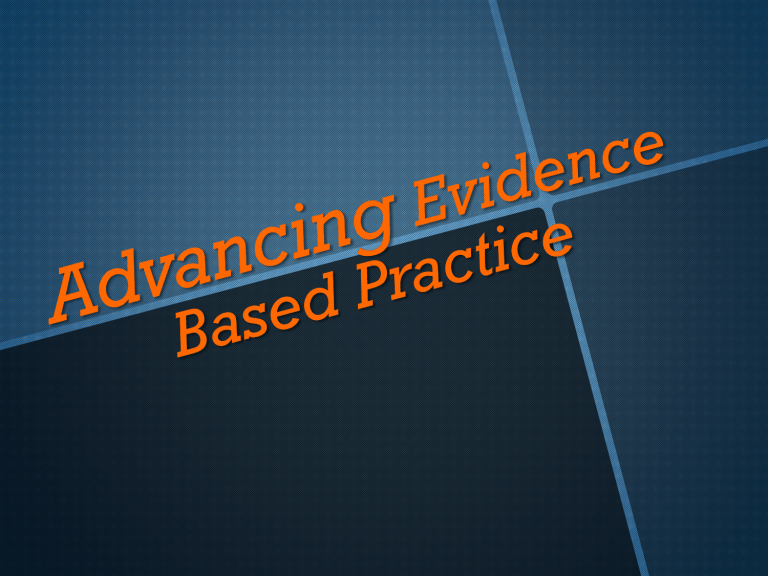
Objectives of Today’s Workshop
•
Define EBP
•
Review levels of evidence
•
Review of EBP proprietary and generic programs
•
State of EBP in Ohio
•
Issues in EBP
What is Evidence-based Practice?
(1) practices or programs that have been judged effective based on rigorous, scientific evaluations; and
(2) a process for insuring that an individual or group of individuals gets the best possible intervention, service, or support based on an assessment of needs, preferences, and available options (U.S.
DHHS)
‘Evidence-based practice cannot deliver certainties, just increase probabilities, and this is the most that any approach claiming to be ‘evidence-based’ can hope to achieve.’
(Newman et al 2005, pp.5)
Evidence-Based Practice
Uses scientific principles to assess the available evidence regarding program effectiveness, and develops principles for best practice in any particular field;
As opposed to practice based on
•
Experience
•
Unproven Theory
Draws Upon Experience in
•
Law: rules for assessing evidence
•
Engineering: codes & standards
•
Public Health: risk factors
•
Medicine: treatment decisions
•
Education: programs and org
•
Ratings for consumer products (i.e. Consumers’
Report, Car and Driver, Gearhead, etc.)
Benefits of EBP
•
Reducing crime
•
Saving money
•
Changing lives
•
Restoring dignity
•
Advancing integrity and professionalism
What EBPs have to offer
•
Proven effectiveness
•
Criminal justice cost savings
•
Blueprint
----------MAYBE ---------------------------
•
Implementing experience - coaching
•
Fidelity measures
•
Outcome tracking and reporting
An Important Qualification
•
Proven programs all require substantial training, ongoing quality assurance & monitoring
•
They only work when implemented with a high degree of fidelity
•
Proven programs account for only a small percentage of the treatment & rehabilitation market
Evidence Based Practice
Begins With A Basic
Logic Model
A Situation Inputs Outputs Outcomes
_____________________________________________________
Problem
Short Medium Long Term
Need
Crisis
Continuum of EBP
Demonstrated
Impact
Demonstrated
Ability to Replicate
Outcomes are consistent across replications
Evidence
Informed
Promising
Findings
Evaluations show better outcomes for participants than for a matched comparison or control group
Evaluations show positive outcomes for participants
--e.g. pre- and post-program evaluations
Research
Informed
The intervention design is based on research evidence about effective practice in this area – e.g. meta-analyses of effective interventions
A strong logic model ties the proposed intervention to what research tells us about how to impact child and family outcomes
Example: One component of a comprehensive parent education and support initiative
Situation: During a county needs assessment, majority of parents reported that they were having difficulty parenting and felt stressed as a result
INPUTS OUTPUTS OUTCOMES
Staff
Develop parented curriculum
Parents increase knowledge of child dev
Parents identify appropriate actions to take
Money
Partners
Deliver series of interactive sessions
Target parents attend
Parents better understanding their own parenting style
Parents use effective parenting practices
Research
Facilitate support groups
Parents gain skills in effective parenting practices
Assumptions: External factors:
Improved childparent relations
Strong families
A Review of Top Tier
Proprietary EBP And
Generic Models
Top Rated Proven Program Models
•
Functional Family Therapy (FFT)
•
Multisystemic Therapy (MST)
•
Multidimensional Treatment Foster Care (MTFC)
•
Nurse Family Partnership
Life Skills Training (LST): The Incredible Years; PATHS
Midwestern Prevention Project; Project Toward No Drug Abuse
Big Brothers Big Sisters: Olweus Bullying Prevention
$90 000
$80 000
$70 000
$60 000
$50 000
$40 000
$30 000
$20 000
$10 000
$0
Three of the Most Effective
Evidence-Based Approaches:
Benefits to Crime
Victims and
Taxpayers
Program Costs
Benefits Minus Costs
Per Participant
MTFC FFT MST
According to Washington State
Institute of Public Policy
$40 000
$20 000
$0
-$20 000
Evidence-Based Practices Versus
Common Alternatives:
Benefits to Taxpayers Minus Costs Per Participant
$100 000
MTFC
$80 000
$60 000
FFT
MST
Intensive
Probation
Intensive
Parole
Scared
Straight
Program Type According to Washington State
Institute of Public Policy
Family Functional Therapy (FFT)
Program:
•
An Empirically grounded, well-documented, and highly successful family intervention for juvenile offenders.
•
Utilizes clinicians in a specific three phase model to engage youth, motivate change, and create change in youths’ behavior.
Method:
•
Intervention ranges from 8-30 one hour direct service sessions with youth and family.
Family Functional Therapy
Accreditations:
•
High rates of effectiveness documented by:
•
Washington State Institute for Public Policy
•
Centers for Disease Control
•
US Surgeon General’s Report on Youth Violence
•
Office of Juvenile Justice and Delinquency Prevention (US DOJ)
•
Center for Substance Abuse Prevention
•
Blueprints (Center for the Study and Prevention of Violence at
University of Colorado)
Multisystemic Therapy (MST)
Program:
•
An individualized approach that targets those factors in each youth’s life that contribute to anti-social behavior.
•
MST interventions focus on caregiver discipline practices, youth associations, improving school performance, and the development of an indigenous support network.
Method:
•
The program requires 3-5 hours of face-to-face contact each week and typically lasts for 3-5 months.
MST Accreditations:
•
High rates of effectiveness documented by:
•
Washington State Institute for Public Policy
•
National Institute for Drug Addiction
•
Center for Substance Abuse Treatment
•
National Association of State Mental Health Program Directors
•
Office of Juvenile Justice and Delinquency Prevention (US DOJ)
•
Blueprints (Center for the Study and Prevention of Violence at
University of Colorado)
Multidimensional Treatment
Foster Care (MTFC)
Program:
•
MTFC addresses chronic antisocial behavior, delinquency, chronic and severe criminal behavior.
•
The MTFC model requires recruitment, training, and close supervision of community families who provide treatment and intensive supervision at home, in school, and in the community.
Method:
•
Live-in treatment with a trained foster family for 6-9+months.
MTFC Accreditations:
•
High rates of effectiveness documented by:
•
Washington State Institute for Public Policy
•
Blueprints (Center for the Study and Prevention of Violence at
University of Colorado)
•
Numerous peer reviewed research reports
Promising Programs
•
Behavioral Monitoring and Reinforcement
•
Brief Strategic Family Therapy (BSFT)
•
FAST Track
•
Good Behavior Game (GBG)
•
Guiding Good Choices (GGC)
•
I Can Problem Solve (ICPS)
•
Linking the Interests of Families
•
Teachers Triple P-Positive Parenting Program
•
Perry Preschool Project
Generic Models from Meta-Analysis
•
Cognitive Behavioral Therapy
•
Behavioral programs
•
Counseling/Psychotherapy
•
Pre-K education for low-income families
•
Teen Court
•
Family Counseling
•
Social skills training
•
Challenge programs
Programs & Strategies That
Do Not Work
•
D.A.R.E
•
Scared Straight
•
Working with at-risk youth in groups
•
Standard probation supervision
•
Punishment
•
Waiver to Adult Court
The State of
Evidence Based Practice
In Ohio
1.
Ohio’s Coordinating Centers of Excellence (CCOEs)
Established by ODMH
Includes Ohio Universities, consumer groups, local agencies
They include:
•
Supported Employment – Case Western Reserve
•
Wellness Management & Recovery – Southeast, Inc., University of
Toledo, and Lorain County MHB
•
Integrated Dual Disorder Treatment – SA/MI Focus – Case Western
Reserve
•
Center for Innovative Practice – Kent State
•
Mental Illness/Developmental Disabilities – Wright State
•
Criminal Justice – Summit County ADAMH Board and Northeastern Ohio
University’s College of Medicine
2.
Ohio Behavioral Health Juvenile Justice Program
Joint effort between ODYS and ODMH
Lucas, Summit, Cuyahoga, Franklin, Montgomery, and Hamilton
Counties
J J Youth with serious behavioral issues
Focus and employing EBP
Case Western Reserve is evaluator
Advancing EBP in
Ohio Juvenile Justice
Targeted Reclaim
•
Funding Metro Counties to employ EBP
H.B. 86 – Ohio’s sentencing reform bill
•
Effective September 30, 2011
•
Explicitly supports EBP
•
Restores judicial discretion
S.H. vs. Stickrath (now Reed)
•
Closed four institutions
•
50% population cut since 2008
•
Invested $57 million in targeted reclaim & BHJJ
•
Increases EBP
EBP and Sex Offender Registration and
Notification Act (SORNA) of Adam Walsh Act
Adam Walsh Act
•
A politically popular but wrong headed strategy
•
Requires sex offender registration based on offense – not risk
•
Research now proves that 97-99% of youthful sex offenders never commit another sex offense
•
Actually decreases public safety
AND NOW:
•
States are refusing to comply
•
Ohio does not comply fully
EBP Resources:
•
Campbell & Cochrane Collaboration Reviews
•
NREPP (SAMHSA)
•
Blueprints
•
CrimeSolutions
•
ChildTrends LINKS
•
Harvard Family Research Project
•
CA What Works Clearinghouse
•
National Child Traumatic Stress Network
Controversy in EBP
•
The great Mark Lipsey
•
Community –defined evidence
•
Push Back to developers
•
DMC (At the heart of Juvenile Justice Reform)
